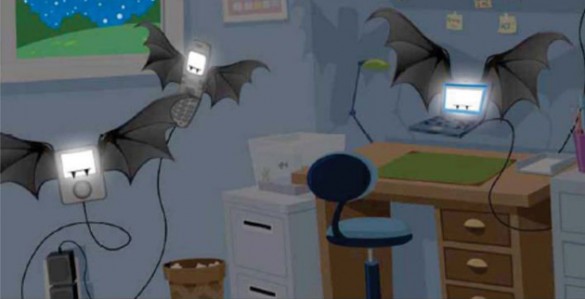
A silent menace may be lurking around your Vanderbilt office or home.
“Energy vampires,” electronic devices that slowly suck energy when they are turned off but still plugged in, provide no useful function and waste energy and money. This is especially true for devices with standby capability—such as a remote control or anything with a constant digital display, including photocopiers, computer monitors, TVs, microwaves, DVD players and stereo systems.
 Curious as to whether your electronics are vampires? Look for a glowing light that remains on even when you power off the device. That means it is still drawing power.
Curious as to whether your electronics are vampires? Look for a glowing light that remains on even when you power off the device. That means it is still drawing power.
Even though each plugged-in device only draws a small amount of energy, that adds up when multiplied by Vanderbilt’s thousands of students and employees.
“Addressing energy vampires is just one more way that we save energy, save money and reduce our greenhouse gas emissions,” said Andrea George, director of Vanderbilt’s Sustainability and Environmental Management Office. “Everyone working together to stop energy vampires can make a real difference.”
According to the Environmental Protection Agency’s Energy Star program, the average U.S. household spends $100 per year to power devices while they are turned off or in standby mode. Nationally, standby power accounts for more than 100 billion kilowatt hours of annual U.S. electricity consumption and more than $10 billion in annual energy costs.
Slaying these vampires is easy: Unplug whatever you’re not using; use an automatic timer to turn off energy consuming lights or electronics when you’re away, at work or in class; and plug electronics into a power strip for an easier and quicker way to turn them off all at once.
October is Energy Awareness Month, so slay some energy vampires to conserve energy and cut costs.
At the office:
- Activate hibernate modes on your computer and other office electronics such as photocopiers, printers and scanners. Turn them off at night when no one is using them, if allowed by your area. (Standby mode on PCs will still allow the computer to draw energy.)
- Plug office equipment into a power strip/surge protector. Shut down the equipment and turn off the power strip at night.
- Turn off lights when you are not using an area of the office during the day, and definitely turn them off before leaving for long periods of time.
At home:
- Unplug cell phones, iPods, iPads, Kindles, Nooks and tablet chargers when not using them. Unplug hand-held vacuums, power drills and automatic coffee makers, etc., when not in use.
- Unplug your phone charger when not in use.
- Donate or unplug the VCR or DVD player you haven’t used in years, the TV that’s collecting dust in the guest room, and the empty refrigerator in the garage.
Note: Some devices such as battery backup systems, cable boxes and computer network servers must be left on at all times to ensure proper functioning.
For more information on which appliances draw energy while plugged in, visit the Lawrence Berkeley National Laboratory website or the EPA’s Energy Star website.
For more energy saving tips, visit SustainVU’s ThinkOne website, join SustainVU on Facebook or sign up to receive the monthly newsletter.
Contact: SustainVU
sustainvu@vanderbilt.edu